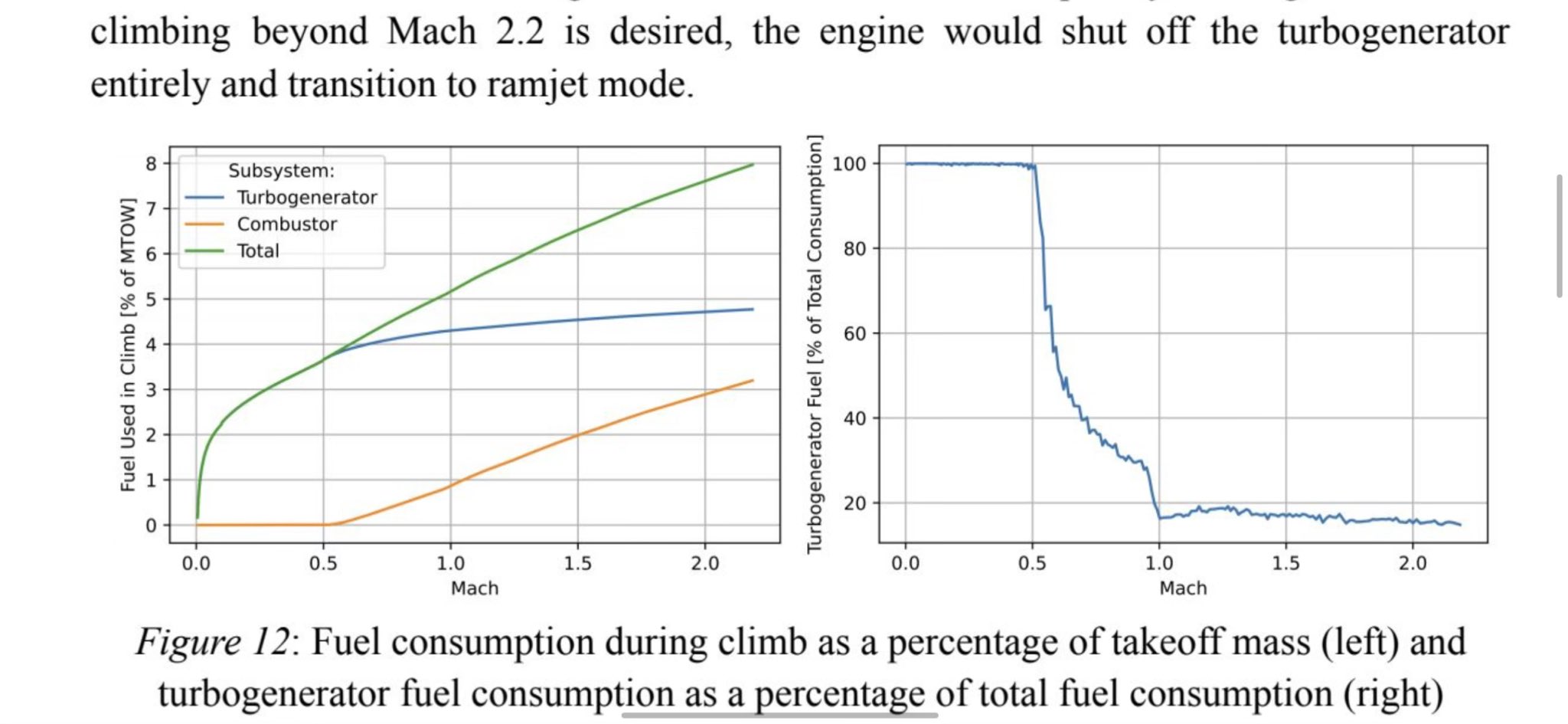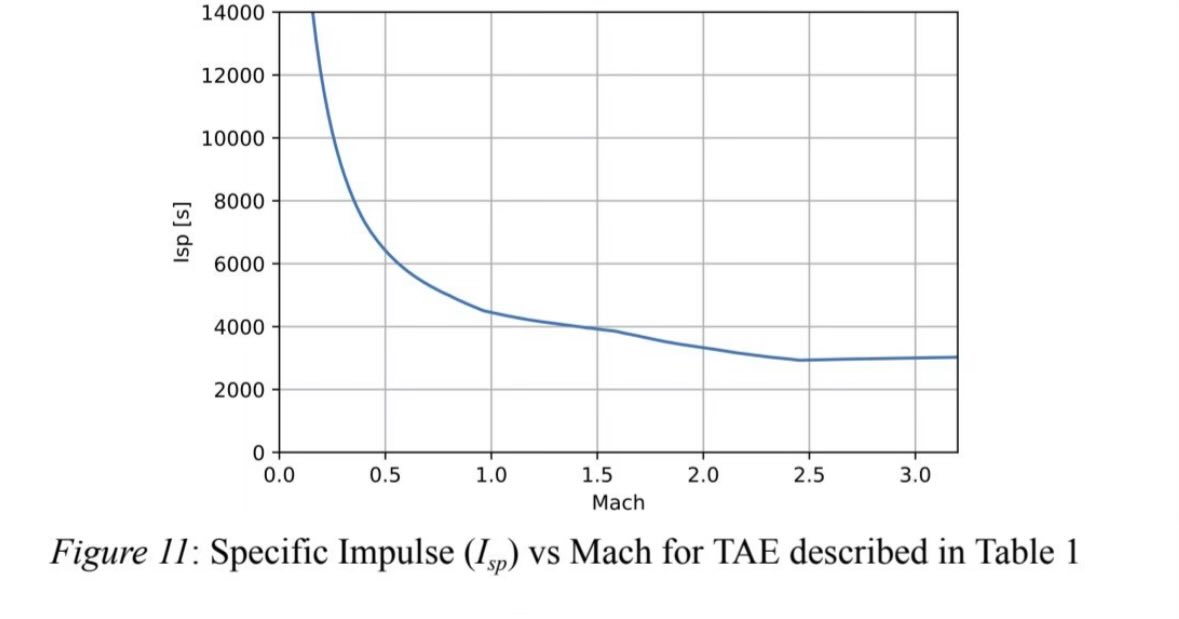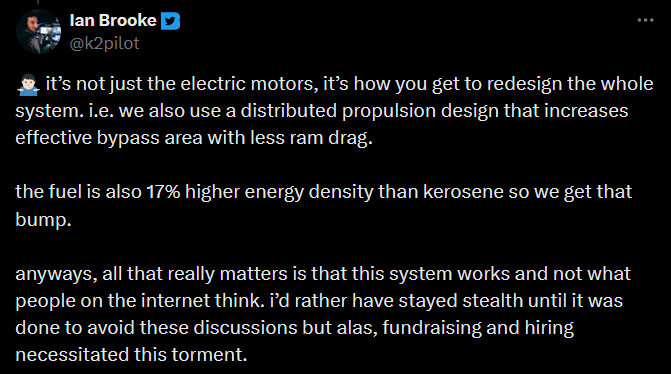=aircraft =engine =flawed
It seems I've been typecast as a
person to ask about "hard tech startups" with big claims that are getting
attention. This time it's been Astro Mechanica, a Y Combinator startup
making aircraft engines. Here's a
video, possibly set up by a PR
agency. Apparently Paul Graham
compared the significance of
their engine to James Watt’s steam engine.
Most large aircraft today
are powered by turbofans, which of course involve a gas turbine that powers
a fan. Some new turbofans have a gear stage between the turbine and the fan,
so the (larger) fan can rotate slower. That seems to work pretty well;
driveshafts and planetary gears usually do.
What Astro Mechanica does
is replace that driveshaft and gear with electric motors. That lets you
continuously vary the relative speed of the fan and gas turbine - but is
that useful? If you change the speed ratio, power production and power usage
become mismatched, and then where do you use/get the extra power?
Even modern axial-flux electric motors have similar power/weight to modern
turbofans, so sending most of the power through 2 electric motors means
you've tripled the engine weight, reduced efficiency, and increased
production cost. Benefits would have to be substantial to justify that.
Supposedly, it's "efficient at every speed", including supersonic speeds.
But why would that be the case? Variable fan speed doesn't get you that;
what you want for that is variable bypass
ratio. The faster an aircraft
travels, the faster you want the engines to send the air backwards. Faster
air ➔ more compression ➔ less air compressed per gas turbine flow ➔ lower
bypass ratio. But electric motors don't let you vary the bypass ratio.
response from founder
Ian
Brooke is the founder of Astro Mechanica. Since I didn't see how their approach was supposed to be better, I tried asking him.
He first wanted to
clarify that at high speeds, most of the fuel usage happens outside the
turbogenerator:

That was already my understanding, and it doesn't explain how electric motors help. It just describes an afterburning turbofan, which has low efficiency. At any speed from 0 to Mach 3, efficiency goes: low-bypass turbofan > turbojet > afterburning turbofan. That's worse efficiency, not better, so I asked about a specific fuel consumption graph, and got this:

That was a puzzling graph to me,
because it shows better efficiency than modern high-bypass turbofans at Mach
0.25 and also better efficiency than turbojets at Mach 3. (A modern turbojet
optimized for Mach 3 can give ~2450s specific impulse.) The former can't
be achieved without a large intake area that makes Mach 3 impractical, and
there's still no reason electric motors are helpful.
Ian replied
that:
- That's with
methane, which has 17% higher specific energy.
- They "also use a
distributed propulsion design that increases effective bypass area with less
ram drag".
- All that matters is that the system works.

Ah, reporting per-mass fuel
efficiency with methane instead of kerosene. Very cheeky. But methane is
harder to store and not a good tradeoff for aircraft...unless they're much
bigger than current aircraft, I suppose, but Astro Mechanica says they want
to enable smaller aircraft.
NASA has been
researching
turboelectric distributed propulsion designs for a while, but while there
are some aerodynamic benefits, they're generally considered not worth the
weight and efficiency penalty. Distributed propulsion matters with
propellers, because of interaction between the wakes of propellers and the
airframe, but with ducted fans...you can still try to do boundary layer
ingestion, but it's definitely less worthwhile than with propellers. In any
case, I consider describing benefits from that as "engine Isp" as incorrect,
and it still doesn't make that graph plausible to me.
Yes, if the
system works, that's fine, but if that's a chart specifically for an
aircraft with integrated propulsion and aerodynamic interactions, well,
that's obviously not something that's working yet. If that's what the
benefit is from, it doesn't make sense to cheer and claim success from
demonstrating a standalone engine. Neither is some distributed propulsion
system a thing that was mentioned in the videos or articles about Astro
Mechanica I looked at, or on their website. A google search for
that
also returns no relevant results.
Well, I do appreciate the founder
taking the time to reply. Perhaps someone else will have a different
interpretation of his comments.
supersonic flight is less efficient
Supersonic aircraft, compared to subsonic aircraft with the same level
of competence, always have 0.5x the lift/drag ratio or worse. Why is that?
Wings produce lift largely because the pressure on their top side is
lower than ambient pressure, which implies higher air speed there, but above
the speed of sound that flow becomes
choked.
We can reduce the
effective air speed of wings by sweeping them. The problem is, lift is
proportional to speed^2 across an airfoil chord, and by sweeping a wing, we
reduce that but don't reduce drag. So, changing effective speed by X with
sweep, we change lift/drag by X^2. Which clearly makes supersonic aircraft
less efficient. That used to be partially compensated for by increased
propulsive efficiency at high speeds, but modern turbofans have a high
bypass ratio that better matches subsonic speeds.
You'll often see
delta wings on supersonic aircraft. Those are effectively the same as highly
swept wings; what matters for sweep is the sweep of the lines of equal air
pressure (isobars). For low drag at high speeds you just need to make sure
none of the isobars have sections with insufficient sweep. (Doing that
reasonably well without CFD is one of my useless talents.)
supersonic aircraft engines
For supersonic aircraft, what you want is a turbofan with lower bypass
ratio than subsonic aircraft use. The higher the speed, the lower the
optimum bypass ratio, until at some point you just want an engine with no
bypass, which is a turbojet. But generally, even for supersonic aircraft,
you want a bypass ratio > 1, unless you're trying to minimize engine costs
in which case you might still want turbojets.
The Concorde used
turbojets; modern low-bypass turbofans can give you ~0.7x the fuel burn at
its cruise speed. You can also burn the compressed air of a low-bypass
turbofan in an afterburner, but afterburning turbofans are less efficient
than turbojets at every speed.
supersonic dreams
There's a
pattern of thought I've seen many times, and multiple times about supersonic
aircraft in particular. It goes like this:
1. future =
inevitable progress
2. progress = faster travel = supersonic travel
3.
Therefore supersonic travel is practical and will be common in the future.
4. Here is the only route to practical supersonic travel we can think of, so
it must work.
Of course, that logic is backwards. But how about that blogger? Why are they so enthusiastic about this startup?
It might surprise you to learn that I am not an aerospace engineer, so to
figure out whether an aerospace engineer like Ian is legit, I need to look
for clues.
One clue might be a video of a working prototype, like the
one we started the piece with.
Another might be an endorsement from
someone like Matt Parlmer.
Another, more important one is the ability to
recruit [former SpaceX] engineers. On that count, Astro Mechanica is legit.
So, clearly none of those are good indicators. Neither is endorsement by Paul Graham - or Bill Gates, or Elon Musk. Most American business leaders and popular bloggers are just completely unable to evaluate novel technology; you might as well roll dice. This is why China has been beating the US at some stuff lately: smarter leadership.
practical aircraft ideas
OK, so I'm not optimistic about replacing turbofan gears with electric
motors, or cost-effective supersonic transport. (Unless you count delivering
explosives as "transport".) But I wouldn't want people to think I just
reject everything new. What novel aircraft things do I think are
feasible?
BWB aircraft are a good idea, as I've
said. They can have
better efficiency and more space for passengers. They're common for new
bomber designs. Passenger aircraft are harder because they need to be
pressurized, but they still seem feasible. The real problem is development
cost given certification requirements for passenger aircraft; it might
simply be too expensive to actually get a BWB passenger aircraft into
production. The 787 cost over $30 billion to develop, and a BWB is a bigger
change than the 787 was.
Truss-braced transonic
wings can significantly
improve efficiency by allowing for a higher wing aspect ratio. The thing is,
that means either:
- a longer
wing, and passenger aircraft are already as wide as airports can handle
-
or less wing surface area, which means increased takeoff distance, which is
also a problem
Because of airport size limits,
braced transonic wing designs are often proposed with folding wingtips, but
of course that has its own problems.
That "Mentour Now" channel is
actually decent; here's its video on
propfans, which are also
feasible. Yes, you can get better efficiency with those, at the cost of
slightly lower cruise speeds, larger engine diameter, and increased noise.
Long-range low-cost autonomous military UAVs. They're coming at some
point. Aren't you excited for that ✨ progress ✨?